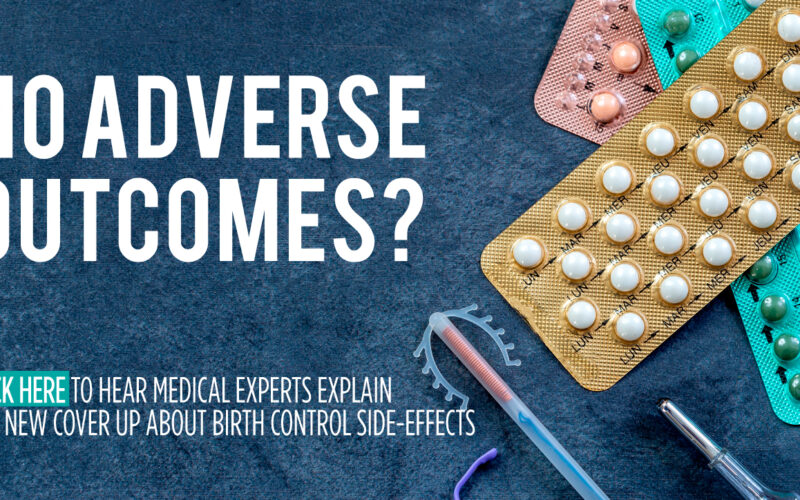“I remember being called to the emergency room one night to see a patient… [who] was in the emergency room with a gyn problem. But in eliciting her history, I learned she had just been discharged from the hospital with a myocardial infarction—a heart attack! She was 32 years old, and she was on birth control pills, and I told her, you need to get off the pill because this caused your heart attack. And she said, ‘No, no, no, the cardiologist told me it had nothing to do with birth control pills.’”
Dr. Kathleen Raviele, an OB/GYN, reported this dramatic story during the recent “No Adverse Outcomes?” Round Table led by Natural Womanhood’s Editor, Grace Emily Stark. Dr. Raviele practiced medicine for several years before she stopped prescribing contraception, and is now retired after 33 years of practice in Atlanta. She was joined on Natural Womanhood’s expert panel by Dr. Bill Williams, MD, Editor Emeritus of The Linacre Quarterly, Adjunct Professor at the University of Pennsylvania, and the lead author of a petition to the FDA requesting more transparency on birth control side effects. Rounding out the panel was scientist Dr. Joel Brind, PhD, Professor Emeritus of Human Biology and Endocrinology at Baruch College of the City University of New York.
The purpose of this live Round Table discussion was to unpack a recent study published in JAMA Network Open, which found “no adverse outcomes” associated with the use of hormonal contraceptives. The JAMA study’s conclusions clearly contradict the findings of the extensive study published in the peer-reviewed journal, The Linacre Quarterly, to support Natural Womanhood’s petition to the FDA. For those unfamiliar with JAMA, it is the Journal of the American Medical Association—one of the United States’ preeminent medical journals. This is not some obscure journal, and any article or study published by them can have an impact on media and policy, misleading many doctors and patients in the end.
So, what is the truth about birth control side effects and risks? And how could this new JAMA study arrive at such radically different conclusions from Natural Womanhood’s petition? What do these discrepancies say about the way science is done in today’s world?
The reality of birth control side effects
Birth control drugs affect many areas of the human body. Contrary to common belief, these drugs are not (and cannot be) solely targeted at a woman’s reproductive system. Take for instance DMPA, the drug compound used in the birth control shot Depo Provera. Per Dr. Joel Brind, “[DMPA] mimics the hormone cortisol.” Women on Depo Provera end up with an unnaturally elevated level of cortisol all day long. As a consequence, this drug affects the brain, which is seen in elevated risks for anxiety and depression symptoms. By other mechanisms, Depo Provera also affects the bones (lower bone density), and the immune system (increased risk of HIV transmission).
The study supporting Natural Womanhood’s petition to the FDA calls for the removal of Depo Provera from the market because of its uniquely serious risks. It also demands better transparency concerning the side effects of other forms of hormonal contraception, through updated prescribing information and package inserts; the study found 14 serious conditions that women may experience as a result of using hormonal contraception (including the combined hormonal pill, the mini-pill or progestin pill, the birth control shot, hormonal IUDs, vaginal rings, and implants), most of which are not currently listed within the prescribing information for these powerful drugs.
Dr. Williams listed some of these risks during our Round Table:
“Breast cancer, cervical cancer, Crohn’s disease (which is an inflammatory bowel disease, which is chronic; it’s a lifelong battle for these patients who have that), ulcerative colitis, and systemic lupus. My training is in Rheumatology, and these [Lupus] patients have a lifelong, debilitating disease which is often very life-threatening. Not to mention depression, which of course is very prevalent in our society.”
While we know progestin-only drugs affect bone density, “evidence is now clear that it’s not just getting your bones softer, but actually bone fractures are increased,” says Dr. Williams. Vascular issues, such as “myocardial infarction and vascular accident—in other words, heart attacks and strokes” are also known.
As a scientist by training, Dr. Brind explained how we can know that these risks and side effects are related to the powerful compounds found in birth control drugs. While epidemiological studies attempt to evaluate the prevalence of such symptoms and risks, Dr. Brind explained, the first step scientists take to check drug risks is to conduct bench studies. These studies assess the biological mechanisms that drug compounds have in the human body, by testing them in-vitro or on animals.
According to Dr. Brind, there are bench studies showing how these side effects take place:
“The fact is, we know what’s going on. We know how these things cause blood clots, we know why the patch is worse than the pill, we know exactly why Depo increases the risk of HIV transmission.”
Dr. Williams adds:
“The mechanism of action of these things on autoimmunity is also pretty well understood, and obviously the link for osteoporosis and bone fractures we really understand. So there is tremendous amount of scientific backup for this.”
The burden of birth control side effects
From an epidemiological standpoint, we also know that the risks levels for these 14 serious conditions are statistically significant. Many women across the country (and the world!) are impacted by the various risks and side effects described in the Natural Womanhood petition, which in turn leads to the need for additional health services.
Dr. Raviele explained that when she stopped prescribing the pill to her patients, it changed her practice:
“No longer did you have all the phone calls coming in every day with abnormal bleeding, and breast lumps and breast tenderness. Patients were actually coming in with gyn problems that you could manage without using birth control pills.”
Dr. Raviele estimates that about a third of an OB/GYN’s time is spent managing complications from the pill.
The study supporting Natural Womanhood’s FDA petition estimates that over 1.2 million US women currently suffer from a negative health condition as a direct result of their use of these drugs. Dr. Williams questioned how women would respond if they knew the real level of risk they’re taking:
“What kind of risk are you willing to take to set yourself up potentially for one of these diseases? Would a 50 [percent] increase in risk kind of put you off? Or 50 percent certainty rather, that you would have an increased risk? Or a 75 [percent] increase? Well, certainly a 95 percent increased risk.”
The issue is that women, on the whole, are unaware of these risks, and so they are unable to make an informed decision about the level of risk they are willing to accept.
For the many women who suffer from painful or heavy periods, for which birth control seems to offer some relief, these elevated risks might seem worth it. However, as our Round Table panelists explained, these drugs do not cure any of these maladies. In fact, birth control is a Band-Aid solution, taking the place of treatments that could address the root causes of conditions that cause painful or heavy periods (like endometriosis, polycystic ovary syndrome, and others) or natural approaches that don’t harm your health.
From the outset, Dr. Williams underscored the key ethical issue present with birth control, which is that it is not a drug that addresses an illness, but one that interrupts a healthy, functioning reproductive system. This should mean that the burden of evidence for safety is much higher. Yet, we see the opposite happening.
The birth control risks cover-up explained
It is always confounding for doctors, patients, and the media to find contradictory studies on these issues. Obviously, those who profit from or simply prefer a “positive” interpretation of the scientific evidence will promote it. Taking the JAMA study in question, the panel discussion was quite enlightening about how such misinformation can be produced and the impact it has.
One way to mislead people is at the mere communication level. In the case of this JAMA study, the title itself was incorrect, indicating that its conclusions covered all forms of hormonal contraception, while the research itself was focused on combined oral contraception (I.e., just combined birth control pills, and not the hormonal IUD, patch, shot, or ring). Few busy physicians (and even fewer patients) will take the time to read the full study conclusion, which explained this exception.
Similarly, the labeling of some birth control pills reports risks of blood clots. But as Dr. Williams explained, the wording on birth control labels “makes it look like the risk is from smoking, and from age, and that the contraceptive just adds a little bit to it. That’s a complete fabrication [or] massaging of the data to reach a conclusion that is clearly not justified.”
But the key to coming up with these contradictory conclusions lies in the way the authors interpret the data. For instance, the authors of the JAMA study “moved the goal posts” by changing the criteria of validity for the data. They essentially discounted findings from studies that previously established high risk by arbitrarily declaring the evidence of those prior studies as “weak.” For example, with blood clots, as Dr. Brind explains:
“[the JAMA study authors] say the risk of thromboembolism among those using [oral contraceptives] versus not using oral contraceptives was an odds ratio of 2.42, which means a 142% risk increase,” [which they arbitrarily deem is not a high enough level evidence]. “They invent this sensitivity analysis to take even things that everybody knows [to be true].. about the risk profile of these drugs.”
Not only did the JAMA authors invent their own metrics, but (as Dr. Brind explained) they also cherry-picked data to selectively skew results. For example, the JAMA authors concluded that there is no increased risk of breast cancer in the years immediately following birth control pill discontinuation, using data from a large cohort study conducted in England that, in fact, showed “a highly significant result: 145 percent increased risk of breast cancer between 15 and 20 years after you stopped using [birth control pills].”
Another shocking tactic used to mask birth control risks and ensure the marketability of these products is to selectively inform certain doctors—but not others. As Dr. Raviele reports:
“All the studies on the thromboembolic phenomenon with birth control pills are not in the OB/GYN literature. They’re in the hematology literature, they’re in the pulmonary literature, they’re in the cardiology literature. So, OB/GYNs don’t see those studies, as they’re never quoted.”
Dr. Raviele also mentioned how, when serious problems with the Ortho Evra patch first emerged, the manufacturer sent out a letter “to everybody in the American College of OB/GYNs showing you how you could explain to patients how they really didn’t have to come off the patch—that this really wasn’t a serious problem for them.”
These practices show, according to Dr. Brind, a “complete turnaround and the complete perversion” of the field of epidemiology:
“When that field was in its infancy, it was in support of the precautionary principle, [which says that] if you find even one study that shows that there is significant harm from something, then you should not market it. It should be unlawful. That’s become completely turned around in order to serve the agenda of those who want to make these dangerous drugs, and want to continue to have them available to as many people as possible.”
When Natural Womanhood’s Round Table moderator Grace Emily Stark asked if the JAMA study could impact the FDA’s determination about drug safety, Dr. Williams added that “if they use this standard of evidence… it would completely change the prescribing information for everything.”
Yet, these studies can (and do) impact policy. For one thing, they maintain a sort of vague, ambiguous public awareness about the reality of birth control risks, such as the risk of cancer or vascular disease. The latest trend in family planning-related health policy has been to push for birth control drugs to be sold over-the-counter in some states, like North Carolina most recently. These policies, which are aided by the public’s unawareness of the seriousness of birth control risks, eliminates an important opportunity for physician intervention.
As Dr. Raviele explained, “it takes the woman away from an encounter with a physician, a nurse practitioner or a PA, and she’s going to be at high risk for having other problems that won’t be picked up.” She mentions STD testing and PAP smears, in particular. There is also the chance that birth control pills obtained over-the-counter without a physician to first take a thorough medical history, may be taken by young women with a family history of clotting disorders—which can (and has) proven deadly for more than one young woman.
“These days everybody talks about ‘following the science.’ What I hate to tell you is that the scientists are not following the science,” says Dr. Brind in closing. “The scientific establishment is now organized in order to prove certain outcomes. They concoct these ‘umbrella studies’ just for this. It’s really outcome-based ‘science.’”
As Grace Emily Stark underscored, the lives and health of women are at stake, and policies influenced by these studies can be very detrimental. There are alternatives, as Dr. Raviele mentioned in her closing comment:
“I would just reassure any women who are on this webinar right now: If they’re on the pill, to be not afraid and come off the pill, and I bet you will find that you feel so much better off hormonal contraception. There are all-natural alternatives that won’t cause you to get breast cancer, cervical cancer, blood clots, autoimmune disorders. And for any physicians out there: There are several training programs that would help train them on how to manage women’s health without being on birth control pills.”







